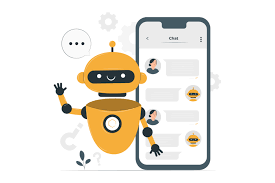AI chatbot development solutions are at the cutting edge of the ongoing AI revolution, which is revolutionizing how companies communicate with their partners, customers, and staff. By 2025, chatbots will have developed into intelligent digital assistants that can have conversations that resemble those of a human, automate processes, and provide individualized user experiences on a large scale.
It’s critical to keep up with the newest tools, technologies, and trends influencing the development of AI chatbots, whether you’re a startup hoping to launch your first bot or an organization trying to modernize your current AI infrastructure.
Here’s everything you need to know about the AI chatbot development solutions to watch in 2025.
1. Trend: Generative AI-Powered Conversations
Modern chatbots can now provide context-aware, human-like responses that adjust to tone, mood, and personality due to developments in generative artificial intelligence (such as OpenAI’s GPT-4.5 and beyond). These bots talk instead of merely reacting.
Why It Matters:
- Dynamic, unscripted conversations
- Personalized user engagement
- Reduced need for hard-coded responses
Use Case: A customer service chatbot that remembers past issues and follows up with relevant solutions—just like a human agent would.
2. Tools: Leading AI Chatbot Development Platforms
The right tools are essential to build effective, scalable chatbot solutions. In 2025, the following platforms will lead the way:
Top AI Chatbot Development Tools:
- Google Dialogflow CX – For advanced conversational design and omnichannel bots.
- Microsoft Bot Framework – Enterprise-grade solution with powerful Azure integration.
- Rasa – Open-source, on-premise, highly customizable framework ideal for privacy-focused industries.
- IBM Watson Assistant – Ideal for businesses needing robust NLP and integration with legacy systems.
- Code Brew Labs Custom Solutions – Tailored chatbot development services for startups and enterprises with industry-specific needs.
Tip: Choose a platform that aligns with your business size, use case, and technical capability.
3. Trend: Industry-Specific AI Chatbot Development Solutions
The development of AI chatbots is no longer generic in 2025. Top companies now offer vertical-specific chatbot solutions optimized for regulatory compliance, domain language, and real-world workflows.
Industry-Focused Use Cases:
- Healthcare: HIPAA-compliant patient support bots
- Banking: Secure KYC, fraud alerts, and transaction bots
- Retail: Personalized shopping assistants and order tracking bots
- Education: Virtual tutors and admissions assistants
- Travel: Real-time booking, check-in, and itinerary bots
Why It Matters: Tailored bots drive better engagement, accuracy, and ROI.
4. Tech: Multimodal & Voice-Enabled Interfaces
AI chatbot development solutions are expanding beyond text. Multimodal bots now understand voice commands, images, videos, and even gestures—delivering richer, more intuitive interactions.
Key Features to Look For:
- Voice recognition and voice-to-text NLP
- Image processing for product support or diagnostics
- AR/VR integration in retail and learning environments
Example: A voice-enabled chatbot in an automotive app that helps users navigate, control car functions, or schedule service appointments—all hands-free.
5. Trend: Built-in Security and Compliance
Top AI chatbot development solutions now come with end-to-end security procedures, compliance tools, and auditability as standard features due to growing data privacy concerns.
Key Compliance Standards:
- GDPR (Europe)
- CCPA (California)
- HIPAA (U.S. healthcare)
- PCI DSS (for financial transactions)
Why It Matters: Secure bots protect brand trust and ensure legal safety, especially in sensitive industries.
6. Tech: AI-Powered Analytics & Continuous Learning
Strong analytics engines that monitor performance and make recommendations for enhancements support the top chatbot development options. To improve accuracy and user pleasure, these bots continuously learn from actual encounters.
Metrics That Matter:
- Intent match rate
- Drop-off points
- Sentiment trends
- Conversation completion rate
Pro Tip: Use AI-driven insights to retrain your bot and improve conversation quality over time.
7. Trend: Seamless Integration Across Ecosystems
Modern AI chatbot development solutions don’t work in silos. They’re built to integrate with CRMs, ERPs, helpdesk platforms, and even IoT systems to offer a truly connected experience.
Integration Examples:
- Salesforce and HubSpot for lead nurturing
- Shopify and Magento for order management
- Zendesk and Freshdesk for support ticket handling
- Slack and Teams for internal workflow automation
Why It Matters: Integrated chatbots streamline operations and reduce manual work.
8. Tech: No-Code & Low-Code Bot Builders
In 2025, companies are adopting no-code and low-code chatbot development solutions to empower non-technical teams to build and manage bots quickly.
Features to Look For:
- Drag-and-drop interface
- Prebuilt templates and flows
- Real-time testing and deployment
- Easy API integrations
Popular Platforms:
- Landbot
- Chatfuel
- Tars
- MobileMonkey
Why It Matters: These tools reduce development time and increase agility for businesses of all sizes.
9. Trend: AI Agents vs. Traditional Chatbots
The evolution from static bots to AI agents marks a major shift in chatbot development. These agents can make decisions, execute multi-step tasks, and operate independently.
Capabilities:
- Trigger workflows across departments
- Schedule meetings, send emails, and process transactions
- Offer personalized experiences based on real-time data
Example: An AI agent that not only answers HR questions but also submits leave requests and updates the calendar.
Final Thoughts
By 2025, AI chatbot development solutions will be more intelligent, customized, and closely integrated into corporate environments. A new era of digital interaction is being made possible by technology, ranging from voice-first interfaces and generative AI to industry-specific and security-focused bots.
Now is the ideal moment to take advantage of these tools, trends, and technologies if you intend to invest in chatbot technology in order to stay ahead of the curve and satisfy consumer expectations.


